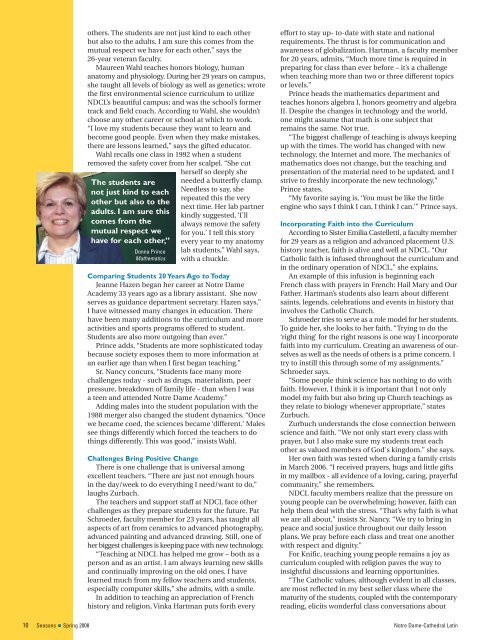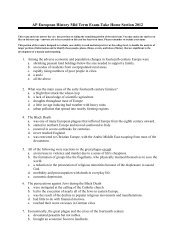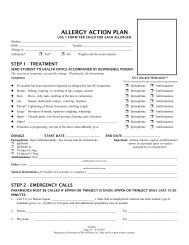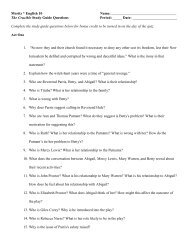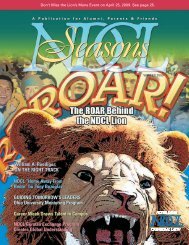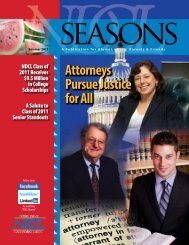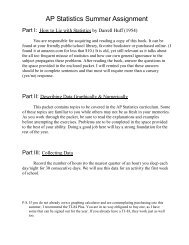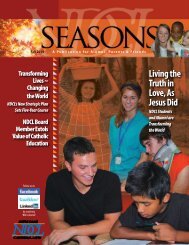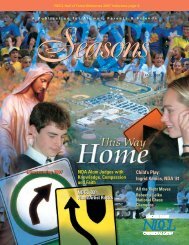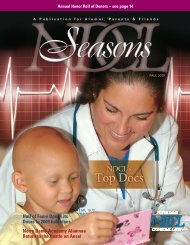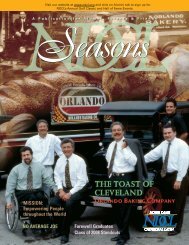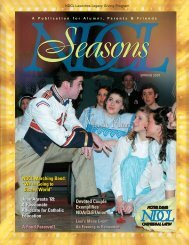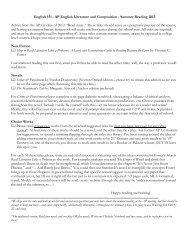Seasons_SPRG08_CVR.ps, page 1-4 @ Normalize ... - eSchoolView
Seasons_SPRG08_CVR.ps, page 1-4 @ Normalize ... - eSchoolView
Seasons_SPRG08_CVR.ps, page 1-4 @ Normalize ... - eSchoolView
You also want an ePaper? Increase the reach of your titles
YUMPU automatically turns print PDFs into web optimized ePapers that Google loves.
others. The students are not just kind to each other<br />
but also to the adults. I am sure this comes from the<br />
mutual respect we have for each other,” says the<br />
26-year veteran faculty.<br />
Maureen Wahl teaches honors biology, human<br />
anatomy and physiology. During her 29 years on campus,<br />
she taught all levels of biology as well as genetics; wrote<br />
the first environmental science curriculum to utilize<br />
NDCL’s beautiful campus; and was the school’s former<br />
track and field coach. According to Wahl, she wouldn’t<br />
choose any other career or school at which to work.<br />
“I love my students because they want to learn and<br />
become good people. Even when they make mistakes,<br />
there are lessons learned,” says the gifted educator.<br />
Wahl recalls one class in 1992 when a student<br />
removed the safety cover from her scalpel. “She cut<br />
herself so deeply she<br />
The students are<br />
not just kind to each<br />
other but also to the<br />
adults. I am sure this<br />
comes from the<br />
mutual respect we<br />
have for each other,”<br />
Donna Prince<br />
Mathematics<br />
needed a butterfly clamp.<br />
Needless to say, she<br />
repeated this the very<br />
next time. Her lab partner<br />
kindly suggested, ‘I'll<br />
always remove the safety<br />
for you.’ I tell this story<br />
every year to my anatomy<br />
lab students,” Wahl says,<br />
with a chuckle.<br />
Comparing Students 20 Years Ago to Today<br />
Jeanne Hazen began her career at Notre Dame<br />
Academy 33 years ago as a library assistant. She now<br />
serves as guidance department secretary. Hazen says,”<br />
I have witnessed many changes in education. There<br />
have been many additions to the curriculum and more<br />
activities and sports programs offered to student.<br />
Students are also more outgoing than ever.”<br />
Prince adds, “Students are more sophisticated today<br />
because society exposes them to more information at<br />
an earlier age than when I first began teaching.”<br />
Sr. Nancy concurs, “Students face many more<br />
challenges today - such as drugs, materialism, peer<br />
pressure, breakdown of family life - than when I was<br />
a teen and attended Notre Dame Academy.”<br />
Adding males into the student population with the<br />
1988 merger also changed the student dynamics. “Once<br />
we became coed, the sciences became ‘different.’ Males<br />
see things differently which forced the teachers to do<br />
things differently. This was good,” insists Wahl.<br />
Challenges Bring Positive Change<br />
There is one challenge that is universal among<br />
excellent teachers. “There are just not enough hours<br />
in the day/week to do everything I need/want to do,”<br />
laughs Zurbach.<br />
The teachers and support staff at NDCL face other<br />
challenges as they prepare students for the future. Pat<br />
Schroeder, faculty member for 23 years, has taught all<br />
aspects of art from ceramics to advanced photography,<br />
advanced painting and advanced drawing. Still, one of<br />
her biggest challenges is keeping pace with new technology.<br />
“Teaching at NDCL has helped me grow – both as a<br />
person and as an artist. I am always learning new skills<br />
and continually improving on the old ones. I have<br />
learned much from my fellow teachers and students,<br />
especially computer skills,” she admits, with a smile.<br />
In addition to teaching an appreciation of French<br />
history and religion, Vinka Hartman puts forth every<br />
effort to stay up- to-date with state and national<br />
requirements. The thrust is for communication and<br />
awareness of globalization. Hartman, a faculty member<br />
for 20 years, admits, “Much more time is required in<br />
preparing for class than ever before – it’s a challenge<br />
when teaching more than two or three different topics<br />
or levels.”<br />
Prince heads the mathematics department and<br />
teaches honors algebra I, honors geometry and algebra<br />
II. Despite the changes in technology and the world,<br />
one might assume that math is one subject that<br />
remains the same. Not true.<br />
“The biggest challenge of teaching is always keeping<br />
up with the times. The world has changed with new<br />
technology, the Internet and more. The mechanics of<br />
mathematics does not change, but the teaching and<br />
presentation of the material need to be updated, and I<br />
strive to freshly incorporate the new technology,”<br />
Prince states.<br />
“My favorite saying is, ‘You must be like the little<br />
engine who says I think I can, I think I can.’” Prince says.<br />
Incorporating Faith into the Curriculum<br />
According to Sister Emilia Castelletti, a faculty member<br />
for 29 years as a religion and advanced placement U.S.<br />
history teacher, faith is alive and well at NDCL. “Our<br />
Catholic faith is infused throughout the curriculum and<br />
in the ordinary operation of NDCL,” she explains.<br />
An example of this infusion is beginning each<br />
French class with prayers in French: Hail Mary and Our<br />
Father. Hartman’s students also learn about different<br />
saints, legends, celebrations and events in history that<br />
involves the Catholic Church.<br />
Schroeder tries to serve as a role model for her students.<br />
To guide her, she looks to her faith. “Trying to do the<br />
‘right thing’ for the right reasons is one way I incorporate<br />
faith into my curriculum. Creating an awareness of ourselves<br />
as well as the needs of others is a prime concern. I<br />
try to instill this through some of my assignments,”<br />
Schroeder says.<br />
“Some people think science has nothing to do with<br />
faith. However, I think it is important that I not only<br />
model my faith but also bring up Church teachings as<br />
they relate to biology whenever appropriate,” states<br />
Zurbuch.<br />
Zurbuch understands the close connection between<br />
science and faith. “We not only start every class with<br />
prayer, but I also make sure my students treat each<br />
other as valued members of God's kingdom.” she says.<br />
Her own faith was tested when during a family crisis<br />
in March 2006. “I received prayers, hugs and little gifts<br />
in my mailbox - all evidence of a loving, caring, prayerful<br />
community,” she remembers.<br />
NDCL faculty members realize that the pressure on<br />
young people can be overwhelming; however, faith can<br />
help them deal with the stress. “That’s why faith is what<br />
we are all about,” insists Sr. Nancy. “We try to bring in<br />
peace and social justice throughout our daily lesson<br />
plans. We pray before each class and treat one another<br />
with respect and dignity.”<br />
For Knific, teaching young people remains a joy as<br />
curriculum coupled with religion paves the way to<br />
insightful discussions and learning opportunities.<br />
“The Catholic values, although evident in all classes,<br />
are most reflected in my best seller class where the<br />
maturity of the students, coupled with the contemporary<br />
reading, elicits wonderful class conversations about<br />
10 <strong>Seasons</strong> Spring 2008 Notre Dame-Cathedral Latin


